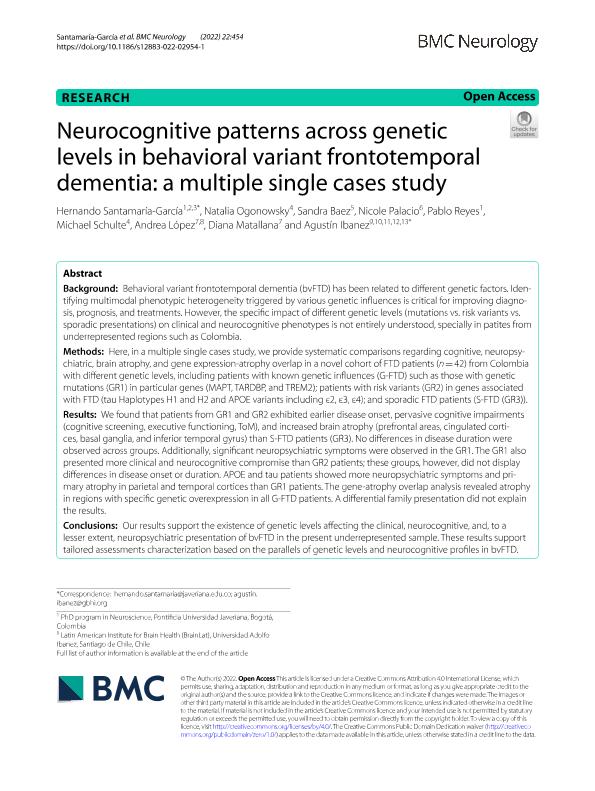Mostrar el registro sencillo del ítem
dc.contributor.author
Santamaría García, Hernando
dc.contributor.author
Ogonowski, Natalia Soledad

dc.contributor.author
Baez, Sandra
dc.contributor.author
Palacio, Nicole
dc.contributor.author
Reyes, Pablo
dc.contributor.author
Schulte, Michael
dc.contributor.author
López, Andrea
dc.contributor.author
Matallana, Diana
dc.contributor.author
Ibañez, Agustin Mariano

dc.date.available
2023-08-09T19:46:06Z
dc.date.issued
2022-12
dc.identifier.citation
Santamaría García, Hernando; Ogonowski, Natalia Soledad; Baez, Sandra; Palacio, Nicole; Reyes, Pablo; et al.; Neurocognitive patterns across genetic levels in behavioral variant frontotemporal dementia: a multiple single cases study; BioMed Central; Bmc Neurology; 22; 1; 12-2022; 1-23
dc.identifier.issn
1471-2377
dc.identifier.uri
http://hdl.handle.net/11336/207694
dc.description.abstract
Background: Behavioral variant frontotemporal dementia (bvFTD) has been related to different genetic factors. Identifying multimodal phenotypic heterogeneity triggered by various genetic influences is critical for improving diagnosis, prognosis, and treatments. However, the specific impact of different genetic levels (mutations vs. risk variants vs. sporadic presentations) on clinical and neurocognitive phenotypes is not entirely understood, specially in patites from underrepresented regions such as Colombia. Methods: Here, in a multiple single cases study, we provide systematic comparisons regarding cognitive, neuropsychiatric, brain atrophy, and gene expression-atrophy overlap in a novel cohort of FTD patients (n = 42) from Colombia with different genetic levels, including patients with known genetic influences (G-FTD) such as those with genetic mutations (GR1) in particular genes (MAPT, TARDBP, and TREM2); patients with risk variants (GR2) in genes associated with FTD (tau Haplotypes H1 and H2 and APOE variants including ε2, ε3, ε4); and sporadic FTD patients (S-FTD (GR3)). Results: We found that patients from GR1 and GR2 exhibited earlier disease onset, pervasive cognitive impairments (cognitive screening, executive functioning, ToM), and increased brain atrophy (prefrontal areas, cingulated cortices, basal ganglia, and inferior temporal gyrus) than S-FTD patients (GR3). No differences in disease duration were observed across groups. Additionally, significant neuropsychiatric symptoms were observed in the GR1. The GR1 also presented more clinical and neurocognitive compromise than GR2 patients; these groups, however, did not display differences in disease onset or duration. APOE and tau patients showed more neuropsychiatric symptoms and primary atrophy in parietal and temporal cortices than GR1 patients. The gene-atrophy overlap analysis revealed atrophy in regions with specific genetic overexpression in all G-FTD patients. A differential family presentation did not explain the results. Conclusions: Our results support the existence of genetic levels affecting the clinical, neurocognitive, and, to a lesser extent, neuropsychiatric presentation of bvFTD in the present underrepresented sample. These results support tailored assessments characterization based on the parallels of genetic levels and neurocognitive profiles in bvFTD.
dc.format
application/pdf
dc.language.iso
eng
dc.publisher
BioMed Central

dc.rights
info:eu-repo/semantics/openAccess
dc.rights.uri
https://creativecommons.org/licenses/by/2.5/ar/
dc.subject
APOE VARIANTS
dc.subject
BVFTD
dc.subject
CLINIC AND NEUROCOGNITIVE PROFILES
dc.subject
COGNITION
dc.subject
FRONTOTEMPORAL DEMENTIA
dc.subject
GENE-ATROPHY ASSOCIATION
dc.subject
GENE-ATROPHY OVERLAP
dc.subject
GENETICS
dc.subject
MAGNETIC RESONANCE IMAGING
dc.subject
MAPT
dc.subject
MUTATIONS
dc.subject
STRUCTURAL NEUROIMAGING
dc.subject
TARDBP
dc.subject
TAU HAPLOTYPES
dc.subject
TREM2
dc.subject.classification
Neurología Clínica

dc.subject.classification
Medicina Clínica

dc.subject.classification
CIENCIAS MÉDICAS Y DE LA SALUD

dc.title
Neurocognitive patterns across genetic levels in behavioral variant frontotemporal dementia: a multiple single cases study
dc.type
info:eu-repo/semantics/article
dc.type
info:ar-repo/semantics/artículo
dc.type
info:eu-repo/semantics/publishedVersion
dc.date.updated
2023-08-09T12:45:49Z
dc.journal.volume
22
dc.journal.number
1
dc.journal.pagination
1-23
dc.journal.pais
Reino Unido

dc.journal.ciudad
Londres
dc.description.fil
Fil: Santamaría García, Hernando. Pontificia Universidad Javeriana; Colombia. Hospital Universitario San Ignacio; Colombia. University of California; Estados Unidos
dc.description.fil
Fil: Ogonowski, Natalia Soledad. Consejo Nacional de Investigaciones Científicas y Técnicas; Argentina. Universidad de San Andrés; Argentina
dc.description.fil
Fil: Baez, Sandra. Universidad de los Andes; Colombia
dc.description.fil
Fil: Palacio, Nicole. Université Mcgill; Canadá
dc.description.fil
Fil: Reyes, Pablo. Pontificia Universidad Javeriana; Colombia
dc.description.fil
Fil: Schulte, Michael. Universidad de San Andrés; Argentina
dc.description.fil
Fil: López, Andrea. Pontificia Universidad Javeriana; Colombia
dc.description.fil
Fil: Matallana, Diana. Pontificia Universidad Javeriana; Colombia
dc.description.fil
Fil: Ibañez, Agustin Mariano. Consejo Nacional de Investigaciones Científicas y Técnicas; Argentina. Universidad Adolfo Ibañez; Chile. Universidad de San Andrés; Argentina. Trinity Collegue; Irlanda. University of California; Estados Unidos
dc.journal.title
Bmc Neurology

dc.relation.alternativeid
info:eu-repo/semantics/altIdentifier/url/https://bmcneurol.biomedcentral.com/articles/10.1186/s12883-022-02954-1
dc.relation.alternativeid
info:eu-repo/semantics/altIdentifier/doi/http://dx.doi.org/10.1186/s12883-022-02954-1
Archivos asociados
